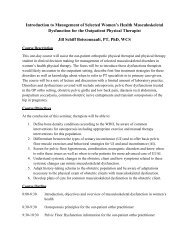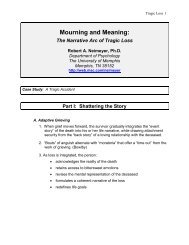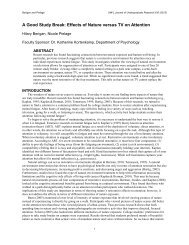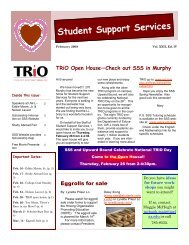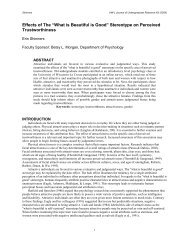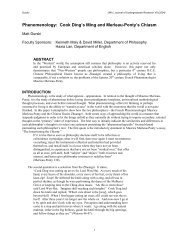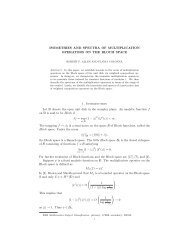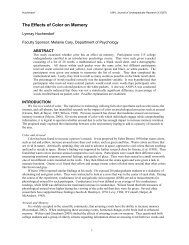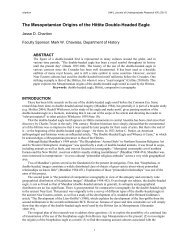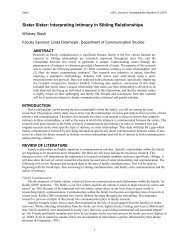Hmong in France: Assimilation and Adaptation - University of ...
Hmong in France: Assimilation and Adaptation - University of ...
Hmong in France: Assimilation and Adaptation - University of ...
Create successful ePaper yourself
Turn your PDF publications into a flip-book with our unique Google optimized e-Paper software.
Xiong UW-L Journal <strong>of</strong> Undergraduate Research VII (2004)<br />
refugees compared to refugees from African or East European countries who also flooded <strong>France</strong> at about the same<br />
time.<br />
In light <strong>of</strong> the fact that <strong>France</strong> was experienc<strong>in</strong>g a rather severe economic depression follow<strong>in</strong>g 30 years <strong>of</strong><br />
relative economic prosperity, what has been termed les trentes glorieuses (1945-1975), the positive reaction to Asian<br />
immigrant presence is even more surpris<strong>in</strong>g. The <strong>Hmong</strong> arrived at a time when xenophobic sentiments were on the<br />
rise, ma<strong>in</strong>ly <strong>in</strong> reaction to the depressed economy whose depression was perceived to be aggravated by the readily<br />
available, cheap labor <strong>of</strong> immigrants, particularly North African immigrants, who had been encouraged to migrate<br />
<strong>in</strong>to <strong>France</strong> to fill the labor gap follow<strong>in</strong>g WWII death tolls. Although immigrants <strong>of</strong> earlier periods <strong>in</strong> French<br />
history met with hostility sometimes as violent as what North Africans <strong>and</strong> the Arab population have been subjected<br />
to, the difference is that former groups—the Germans, Portuguese, Italians, Spanish—shared similar physical<br />
characteristics <strong>and</strong> a similar European culture. Any issues <strong>of</strong> “us” <strong>and</strong> “them” disappeared over time as<br />
<strong>in</strong>termarriages <strong>and</strong>/or adaptation, result<strong>in</strong>g <strong>in</strong> complete assimilation, occurred. It is worth not<strong>in</strong>g that many Africans<br />
<strong>and</strong> Southeast Asians have been <strong>in</strong> <strong>France</strong> for several decades, yet the widespread assumption that fr<strong>in</strong>ges on<br />
condemnation that they are “<strong>in</strong>assimilable” hangs over their heads. Their descendants, born on French soil,<br />
speak<strong>in</strong>g fluent French, perhaps even assimilat<strong>in</strong>g completely French culture, are still termed les immigrés † (Stovall<br />
5-10).<br />
French <strong>Assimilation</strong>ist Theory<br />
The “problem” <strong>of</strong> the <strong>in</strong>assimilability <strong>of</strong> these recent groups h<strong>in</strong>ts at a characteristic <strong>of</strong> French society that<br />
dist<strong>in</strong>guishes it from pluralist countries like Great Brita<strong>in</strong> <strong>and</strong> Canada. <strong>France</strong> does not <strong>of</strong>ficially recognize the<br />
concept <strong>of</strong> “race” or “ethnicity” (Cognet 1). In accordance with its republican universalist ideals—legacy <strong>of</strong> the<br />
French Revolution (1789-1815)—which sought to elim<strong>in</strong>ate all societal <strong>in</strong>equalities <strong>in</strong> French society, it embraces<br />
the view that all people are similar. Differences lay only <strong>in</strong> nuances <strong>in</strong> language <strong>and</strong> customs, which, fabricated by<br />
history, are “accidental <strong>and</strong> superficial” (Duffy 198). Inclusion <strong>in</strong> the French identity is, therefore, not determ<strong>in</strong>ed<br />
by race, culture, or ethnic orig<strong>in</strong>s.<br />
<strong>France</strong>’s refusal to stress particularities has traditionally justified an aggressive assimilationist policy toward its<br />
immigrants. The <strong>Hmong</strong> are no exception. In anticipation <strong>of</strong> the welcom<strong>in</strong>g <strong>of</strong> these ex-colonial subjects, <strong>France</strong><br />
put <strong>in</strong>to place an extensive welcom<strong>in</strong>g network whose pr<strong>in</strong>ciple goal was their immediate <strong>in</strong>tegration <strong>in</strong>to French<br />
culture <strong>and</strong> French society (Gilles 22). Integration naturally came easier if the refugees had had prior contact with<br />
anyth<strong>in</strong>g French. Thus, French <strong>of</strong>ficials <strong>in</strong> the refugee camps <strong>in</strong> Thail<strong>and</strong>, where the <strong>Hmong</strong> had fled to escape<br />
persecution, were <strong>in</strong>structed to accept discrim<strong>in</strong>ately persons who demonstrated a m<strong>in</strong>imal knowledge <strong>of</strong> the French<br />
language <strong>and</strong>/or who had served under the French military or civil service <strong>in</strong> Indoch<strong>in</strong>a (Gilles 25). Refugees would<br />
also be accepted if they had family already liv<strong>in</strong>g <strong>in</strong> <strong>France</strong>, or if they could prove that they were flee<strong>in</strong>g<br />
persecution.<br />
Upon the refugees’ arrival <strong>in</strong> <strong>France</strong>, Red Cross volunteers went to welcome them at the airport <strong>and</strong> took them<br />
to centers <strong>of</strong> transit. There they spent about 2 weeks gett<strong>in</strong>g medical check ups <strong>and</strong> fill<strong>in</strong>g out essential paperwork<br />
for their stay <strong>in</strong> their new home. Then they were transported to des centres provisoires d’hébergement, or temporary<br />
hous<strong>in</strong>g centers, heret<strong>of</strong>ore referred to as CPH’s, where they lived for 6 months (Gilles 27). This 6-month period<br />
was ideally the time for them to become <strong>in</strong>tegrated <strong>in</strong>to French life. They were <strong>in</strong>troduced to modern wonders like<br />
electricity, runn<strong>in</strong>g water, cook stoves, <strong>and</strong> the refrigerator. They attended class everyday to learn to read <strong>and</strong> write<br />
French. In the meantime, another organization looked for a permanent home for each family. ‡<br />
It should be stressed that although Asian immigrants <strong>in</strong> <strong>France</strong> have also come under much xenophobic attack,<br />
their experience doesn’t beg<strong>in</strong> to parallel the experiences <strong>of</strong> their Arab <strong>and</strong> African immigrant counterparts because<br />
they benefit from a favorable impression civilians have <strong>of</strong> them. The stereotype is that they are a submissive,<br />
humble, <strong>and</strong> hardwork<strong>in</strong>g people. They are <strong>France</strong>’s “model m<strong>in</strong>ority.”<br />
It has been estimated that 15,000 <strong>Hmong</strong> currently live <strong>in</strong> <strong>France</strong>. The figure should not be taken for fact as the<br />
French do not recognize the idea <strong>of</strong> a m<strong>in</strong>ority <strong>and</strong> so do not keep <strong>of</strong>ficial demographic records <strong>of</strong> their m<strong>in</strong>ority<br />
populations. Records that are made by INSEE (Institut National de la Statistique et des Etudes Economiques) erase<br />
any trace <strong>of</strong> “<strong>Hmong</strong>,” anyway, because “ethnicity” does not <strong>of</strong>ficially exist. All <strong>Hmong</strong> are <strong>of</strong>ficially Laotians.<br />
Thus, most <strong>Hmong</strong> refugees carry the <strong>of</strong>ficial nationality <strong>of</strong> “Laotian d’orig<strong>in</strong>e <strong>Hmong</strong>.” §<br />
† immigrants<br />
‡ For further read<strong>in</strong>g on immigration procedures <strong>of</strong> Southeast Asians, see Claude Gilles, Franche-Comté, terre<br />
d’accueil: Cambodgiens, Laotians, <strong>Hmong</strong>, Vietnamiens, Paris: L’Harmattan, 2000.<br />
§ Laotian <strong>of</strong> <strong>Hmong</strong> Orig<strong>in</strong>s<br />
2



